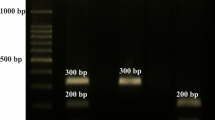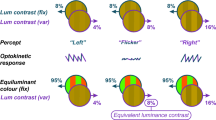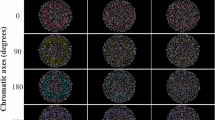Abstract
ONE of us has described the heredity of normal colour vision1. In a publication on colour vision and its defects, the other2 has discussed the parallelism between the symptoms of deuteranomaly and protanomaly and stressed particularly the bimodality which is seen in almost all of the colour assessments of the two groups. It is often the case that comparable colour judgments or colour experiences in deuteranomaly are connected with a longer wavelength, and in protanomaly to a shorter one. A few examples can be mentioned. Rubin3 found that the spectrum locus of pure yellow is at 583 nm for deuteranomals and at 563 for protanomals; for “balanced” orange his respective values were 612 and 590 nm and for pure green they were 520 and 502 nm. Chapanis4 noted a similar bimodality of the locus of maximum desaturation in the spectrum of the red and green anomalies at about 500 nm in deuteranomaly and at about 490 nm in protanomaly, while Jameson and Hurvich5 found the same type bimodality in the wavelength discrimination curves of these subjects (in the locus of their maximum sensitivity to the change of wavelength). Even their maxima of light sensitivity show this bimodality (see, for example, ref. 6). Clearly, deuteranomaly and protanomaly arc independent defects of either a red or a green sensory process. They are merely subtypes of a single defect of red and green colour vision and possibly depend on two kinds of mutation at the same chromosomal locus7,8.
This is a preview of subscription content, access via your institution
Access options
Subscribe to this journal
Receive 51 print issues and online access
$199.00 per year
only $3.90 per issue
Buy this article
- Purchase on Springer Link
- Instant access to full article PDF
Prices may be subject to local taxes which are calculated during checkout
Similar content being viewed by others
References
Waaler, G. H. M., Nature, 215, 406 (1967).
Linksz, A., An Essay on Color Vision and Clinical Color-Vision Tests (Grune and Stratton, New York and London, 1964).
Rubin, M. L., Amer. J. Ophthalmol., 52, 166 (1961).
Chapanis, A., J. Exp. Psychol., 34, 24 (1944).
Jameson, D., and Hurvich, L. M., J. Opt. Soc. Amer., 46, 1075 (1956).
Wright, W. D., Researches in Normal and Defective Colour Vision (St Louis, Mosby, 1947).
Waaler, G. H. M., Z. f. Indukt. Abst. Vererb. Lehre, 45, 279 (1927).
Waaler, G. H. M., Avh. D. N. Vidensk.-Akad., No. 9 (1967).
Richards, W., J. Opt. Soc. Amer., 57, 1047 (1967).
Author information
Authors and Affiliations
Rights and permissions
About this article
Cite this article
LINKSZ, A., WAALER, G. Naming of Groups with Normal Colour Vision. Nature 218, 687–688 (1968). https://doi.org/10.1038/218687a0
Received:
Issue Date:
DOI: https://doi.org/10.1038/218687a0
This article is cited by
-
Two Genetic Types of Normal Colour Vision?
Nature New Biology (1973)
Comments
By submitting a comment you agree to abide by our Terms and Community Guidelines. If you find something abusive or that does not comply with our terms or guidelines please flag it as inappropriate.



